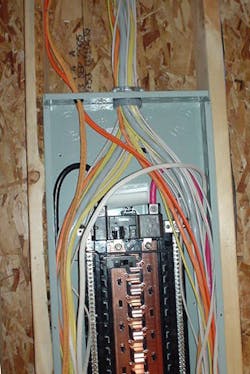How well do you know the Code? Think you can spot violations the original installer either ignored or couldn't identify? Here's your chance to moonlight as an electrical inspector and second-guess someone else's work from the safety of your living room or office. Joe Tedesco, who has a knack for finding shoddy electrical work, did the dirty work and found this mess. Now it's your turn to identify the violation.
Find the Answer
Answer:
A Virginia-based home inspector recently shared these photos with me, indicating that this type of workmanship was fairly common practice in this area. They depict some residential wiring work that had just passed inspection. He was not only concerned about the poor workmanship, but also wondered how all the branch circuits running through a single CE connector, along with the CE cable, could have possibly met local code requirements. He also noticed that the RG6 cable was run right alongside all the home runs.
In this first photograph, the bundle of cables running through the top of this cabinet will not pass a rough inspection because each cable is required to be secured to the cabinet with a proper type of fitting [312.5(C)]. Although some fittings are designed for more that one cable, this installation is extreme.
An Exception to 312.5 states “Cables with entirely nonmetallic sheaths shall be permitted to enter the top of a surface-mounted enclosure through one or more nonflexible raceways not less than 450 mm (18 in.) and not more than 3.0 m (10 ft) in length, provided all of the following conditions are met:
- ”(a) Each cable is fastened within 300 mm (12 in.), measured along the sheath, of the outer end of the raceway.”
- ”(b) The raceway extends directly above the enclosure and does not penetrate a structural ceiling.”
- ”(c) A fitting is provided on each end of the raceway to protect the cable(s) from abrasion and the fittings remain accessible after installation.”
- ”(d) The raceway is sealed or plugged at the outer end using approved means so as to prevent access to the enclosure through the raceway.”
- ”(e) The cable sheath is continuous through the raceway and extends into the enclosure beyond the fitting not less than 6 mm (1 / 4 in.).”
- ”(f) The raceway is fastened at its outer end and at other points in accordance with the applicable article.”
- ”(g) Where installed as conduit or tubing, the allowable cable fill does not exceed that permitted for complete conduit or tubing systems by Table 1 of Chapter 9 of this Code and all applicable notes thereto.”
- ”FPN: See Table 1 in Chapter 9, including Note 9, for allowable cable fill in circular raceways. See 310.15(B)(2)(a) for required ampacity reductions for multiple cables installed in a common raceway.”
In this second photograph, the mixing of cable types passing through the same hole in the structural member can also be cited. For example, rules in Chapter 8 require a space between the power and low energy system cables. Coaxial cables and network-powered broadband cables are required to be separated at least 50 mm (2 in.) from conductors of any electric light, power, Class 1, non–power-limited fire alarm, or medium power network-powered broadband communications circuits.
> Try Another Quiz
About the Author
Joe Tedesco
Tedesco served the industry in many roles during his career. He was a director, senior electrical code instructor for National Technology Transfer, Inc. and American Trainco, Inc.. He was also a codes, standards and seminar specialist for the International Association of Electrical Inspectors and an electrical field service specialist for the National Fire Protection Association in Quincy, Mass. He ran his own business as an NEC consultant and is a Massachusetts licensed master electrician and journeyman electrician and certified electrical inspector (one and two family 2A; General 2B, and Plan Review, 2C). Tedesco also wrote articles for CEE News and EC&M (Code Violations Illustrated and What's Wrong Here?) for more than 15 years and helped launched the Moving Violations video series.
